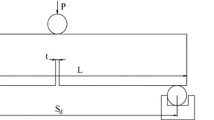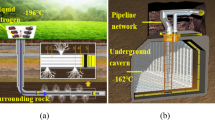Abstract
The degree of water saturation significantly affects the rate of rock deterioration caused by freeze–thaw weathering, which may trigger serious geological engineering hazards. This study aimed to explore the impacts of water saturation on freeze–thaw-induced deterioration of sandstone, and to improve our understanding of this damage mechanism. Sandstone specimens with varying degrees of moisture saturation were subjected to freeze–thaw tests, computed tomography scanning, and uniaxial compressive tests. The distribution of the areal porosity along the computed tomography slices, evolution of the pore volume, and changes in the pore network model parameters of the sandstone samples were visually and quantitatively characterised to assess the damage evolution. The results show that the parameters of the pore-fracture structure reflect the influence of saturation and cyclic freeze–thaw actions on rock deterioration. As the moisture saturation increased, the sandstone transformed from being dominated by pores with a radius ranging from 0 to 100 μm to being dominated by pores of 200–300 μm. The increase in the equivalent radii of pores caused the rock to be more susceptible to deformation and failure, whereas an increase in the number of throats represents a disruption of the cementation between the rock grains, making to rock more susceptible to freeze–thaw actions. Furthermore, the damage mechanisms of sandstone can be interpreted by volumetric expansion and hydrostatic pressure theory in a rapid freeze–thaw environment. The results of this study provide a comprehensive insight into the influence of water saturation on freeze–thaw-induced damage evolution of rocks in cold regions.
Highlights
-
With the increase of water saturation, the radius of the dominant pores in the rock gradually expands.
-
With the increase of saturation, the number of throats between connected pores increases, which disrupts the cementation between the rock grains, thereby making the rock more susceptible to freeze–thaw cycles.
-
The frost heave force accelerates the coalescence of pores and prolong the pore closure stage in the stress–strain curves of the tested rocks.
-
Volumetric expansion and hydrostatic pressure are jointly responsible for the damage caused by freeze–thaw cycles.












Similar content being viewed by others
Data Availability
The data that support the findings of this study are available upon reasonable request from the corresponding author.
References
Akagawa S, Fukuda M (1991) Frost heave mechanism in welded tuff. Permafr Periglac Process 2(4):301–309. https://doi.org/10.1002/ppp.3430020405
Anderson RS, Anderson1 SP, Tucker GE (2013) Rock damage and regolith transport by frost: an example of climate modulation of the geomorphology of the critical zone. Earth Surf Process Landf 38:299–316. https://doi.org/10.1002/esp.3330
Arosio D, Longoni L, Papini M et al (2018) Analysis of microseismic signals collected on an unstable rock face in the Italian Prealps. Geophys J Int 213(1):475–488. https://doi.org/10.1093/gji/ggy010
Bridgman PW (1913) Thermodynamic properties of twelve liquids between 20 degrees and 80 degrees and up to 12000 kgm per sq cm. Proc Am Acad Arts Sci. https://doi.org/10.2307/20025445
Chen YL, Ni J, Jiang LH et al (2014) Experimental study on mechanical properties of granite after freeze–thaw cycling. Environ Earth Sci 71(8):3349–3354. https://doi.10.1007/s12665-013-2725-0
Fan LF, Gao JW, Wu ZJ et al (2018) An investigation of thermal effects on micro-properties of granite by X-ray CT technique. Appl Therm Eng 140:505–519. https://doi.org/10.1016/j.applthermaleng.2018.05.074
Gao F, **ong X, Zhou KP et al (2019) Strength deterioration model of saturated sandstone under freeze-thaw cycles. Rock Soil Mech. https://doi.org/10.16285/j.rsm.2017.1886. ((in Chinese))
Gilpin RR (1980) A Model for the pediction of ice lensing and frost heave in soils. Water Resour Res 16(5):918–930. https://doi.org/10.1029/WR016i005p00918
Halsey DP, Mitchell DJ, Dews SJ (1998) Influence of climatically induced cycles in physical weathering. Quart J Eng Geol 31:359–367. https://doi.org/10.1144/GSL.QJEG.1998.031.P4.09
Huang S, Liu Q, Liu Y et al (2018a) Freezing strain model for estimating the unfrozen water content of saturated rock under low temperature. Int J Geomech 18(2):04017137. https://doi.org/10.1061/(ASCE)GM.1943-5622.0001057
Huang S, Liu Q, Liu Y et al (2018b) Frost heaving and frost cracking of elliptical cavities (fractures) in low-permeability rock. Eng Geol 234:1–10. https://doi.org/10.1016/j.enggeo.2017.12.024
Huang S, Liu Y, Guo YL et al (2019) Strength and failure characteristics of rock-like material containing single crack under freeze-thaw and uniaxial compression. Cold Reg Sci Technol 162:1–10. https://doi.org/10.1016/j.coldregions.2019.03.013
Huo C, ** XG, He J et al (2022) Experimental studies on the pore structure and mechanical properties of anhydrite rock under freeze-thaw cycles. J Rock Mech Geotech Eng. https://doi.org/10.1016/j.jrmge.2021.10.005
Isaka BLA, Ranjith PG, Rathnaweera TD et al (2019) Quantification of thermally-induced microcracks in granite using X-ray CT imaging and analysis. Geothermics 81:152–167. https://doi.org/10.1016/j.geothermics.2019.04.007
Jamshidi A, Nikudel MR, Khamehchiyan M (2013) Predicting the long-term durability of building stones against freeze–thaw using a decay function model. Cold Reg Sci Technol 92:29–36. https://doi.org/10.1016/j.coldregions.2013.03.007
Kolay E (2016) Modeling the effect of freezing and thawing for sedimentary rocks. Environ Earth Sci. https://doi.org/10.1007/s12665-015-5005-3
Li B, Zhang G, Ma W et al (2022) Damage mechanism of sandstones subject to cyclic freeze–thaw (FT) actions based on high-resolution computed tomography (CT). Bull Eng Geol Env 81(9):1–16. https://doi.org/10.1007/s10064-022-02872-z
Liu QS, Xu GM, Liu XY (2008) Experimental and theoretical study on freeze-thawing damage propagation of saturated rocks. Int J Mod Phys 9:1853–1858. https://doi.org/10.1142/S0217979208047523
Liu QS, Huang SB, Kang YS (2015) A prediction model for uniaxial compressive strength of deteriorated rocks due to freeze-thaw. Cold Reg Sci Technol 120:96–107. https://doi.org/10.1016/j.coldregions.2015.09.013
Lozinski WV (1909) Über die mechanische Verwitterung der Sandsteine im gemässigten Klima. Bulletin International De L’academie Des Sciences De Cracovie Class Des Sciences 1:1–25
Lu Y, Li XP, Chan A (2019) Damage constitutive model of single flaw sandstone under freeze-thaw and load. Cold Reg Sci Technol 159:20–28. https://doi.org/10.1016/j.coldregions.2018.11.017
Girard L, Gruber S, Weber S et al (2013) Environmental controls of frost cracking revealed through in situ acoustic emission measurements in steep bedrock. Geophys Res Lett 40(9):1748–1753. https://doi.org/10.1002/grl.50384
Ou K, Wang CS, Cao RH et al (2023) Experimental investigation of the pore fractal characteristics and damage degradation mechanism of sandstone after cyclic freeze-thaw treatments. J Mater Res Technol. https://doi.org/10.1016/j.jmrt.2023.02.077
Park K, Kim K, Lee K et al (2020) Analysis of effects of rock physical properties changes from freeze-thaw weathering in NyÅlesund region Part 1—experimental study. Appl Sci 10(5):1707. https://doi.org/10.3390/app10051707
Peng R, Yang Y, Ju Y et al (2011) Computation of fractal dimension of rock pores based on gray CT images. China Sci Bull 56:3346–3357. https://doi.org/10.1007/s11434-011-4683-9
Powers TC (1945) A working hypothesis for further studies of frost resistance of concrete. J Am Concr Inst 16:245–272. https://doi.org/10.14359/8684
Prick A (1995) Dilatometrical behaviour of porous calcareous rock samples subjected to freeze-thaw cycles. Catena 25(1–4):7–20. https://doi.org/10.1016/0341-8162(94)00038-G
Song Y, Tan H, Yang H et al (2021) Fracture evolution and failure characteristics of sandstone under freeze-thaw cycling by computed tomography. Eng Geol 294:106370. https://doi.org/10.1016/j.enggeo.2021.106370
Taber S (1929) Frost heaving. J Geol 37(5):428–461.https://doi.org/10.1086/623637
Taber S (1930) The mechanics of frost heaving. J Geol 38(4):303–317. https://doi.org/10.1086/623720
Taber S (1950) Intensive frost action along lake shores. Am J Sci 248(1):784. https://doi.org/10.2475/ajs.248.11.784
Tan X, Chen W, Yang J et al (2011) Laboratory investigations on the mechanical properties degradation of granite under freeze–thaw cycles. Cold Reg Sci Technol 68(3):130–138. https://doi.org/10.1016/j.coldregions.2011.05.007
Walder J, Hallet B (1985) A theoretical-model of the fracture of rock during freezing. Geol Soc Am Bull 96(3):336–346. https://doi.org/10.1130/0016-7606(1985)962.0.CO;2
Wang Y, Han JQ, Song ZY et al (2021) Macro-meso failure behavior of pre-flawed hollow-cylinder granite under multi-level cyclic loads: Insights from acoustic emission and post-test CT scanning. Eng Fract Mech 258:108074. https://doi.org/10.1016/j.engfracmech.2021.108074
Wang TT, Li PF, Tang CA et al (2022) Tensile characteristics and fracture mode of frozen fractured rock mass based on Brazilian splitting tes. Appl Sci 12:11788. https://doi.org/10.3390/app122211788
Wang G, Shen JN, Liu SM et al (2019) Three-dimensional modeling and analysis of macro-pore structure of coal using combined X-ray CT imaging and fractal theory. Int J Rock Mech Min Sci 123:104082. https://doi.org/10.1016/j.ijrmms.2019.104082
Wang Y, Feng WK, Wang HJ et al (2020) Rock bridge fracturing characteristics in granite induced by freeze-thaw and uniaxial deformation revealed by AE monitoring and post-test CT scanning. Cold Reg Sci Technol 177:103115. https://doi.org/10.1016/j.coldregions.2020.103115
Watanabe K, Wake T (2009) Measurement of unfrozen water content and relative permittivity of frozen unsaturated soil using NMR and TDR. Cold Reg Sci Technol. https://doi.org/10.1016/j.coldregions.2009.05.011
Xu SH, Li N, Xu GG et al (2016) Thermal transfer and heat balance of saturated rock under freezing-thawing environment. Chin J Rock Mech Eng 35(11):2225–2236. https://doi.org/10.13722/j.cnki.jrme.2016.0333(in Chinese)
Yang C, Zhou KP, **ong X et al (2021) Experimental investigation on rock mechanical properties and infrared radiation characteristics with freeze-thaw cycle treatment. Cold Reg Sci Technol 183:103232. https://doi.org/10.1016/j.coldregions.2021.103232
Zhang MY, Zhang XY, Lu JG et al (2018) Analysis of volumetric unfrozen water contents in freezing soils. Exp Heat Transf. https://doi.org/10.1080/08916152.2018.1535528
Zhang XP, Wong LNY (2013) Crack initiation, propagation and coalescence in rock-like material containing two flaws: a numerical study based on bonded-particle model approach. Rock Mech Rock Eng 46:1001–1021. https://doi.org/10.1007/s00603-012-0323-1
Zhu T, Chen J, Huang D et al (2021) A DEM-based approach for modeling the damage of rock under freeze-thaw cycles. Rock Mech Rock Eng 54(6):2843–2858. https://doi.org/10.1007/s00603-021-02465-4
Acknowledgements
This research was supported by the Second Tibetan Plateau Scientific Expedition and Research (STEP) program (Grant No. 2019QZKK0905); the Strategic Priority Research Program of the Chinese Academy of Sciences (Grant No. XDA19070504); the Program of the State Key Laboratory of Frozen Soil Engineering (Grant No. SKLFSE-ZT-202110); the Guangdong Provincial Key Laboratory of Modern Civil Engineering Technology (2021B1212040003); the Science and Technology Plan of Gansu Province (22JR5RA059).
Funding
Second Tibetan Plateau Scientific Expedition and Research (STEP) program, 2019QZKK0905, Strategic Priority Research Program of the Chinese Academy of Sciences, XDA19070504, Program of the State Key Laboratory of Frozen Soil Engineering, SKLFSE-ZT-202110, Guangdong Provincial Key Laboratory of Modern Civil Engineering Technology, 2021B1212040003.
Author information
Authors and Affiliations
Corresponding author
Ethics declarations
Conflict of Interest
The authors have no known competing interests or personal relationships that could have appeared to influence the work reported in this paper.
Additional information
Publisher's Note
Springer Nature remains neutral with regard to jurisdictional claims in published maps and institutional affiliations.
Rights and permissions
Springer Nature or its licensor (e.g. a society or other partner) holds exclusive rights to this article under a publishing agreement with the author(s) or other rightsholder(s); author self-archiving of the accepted manuscript version of this article is solely governed by the terms of such publishing agreement and applicable law.
About this article
Cite this article
Ju, X., Niu, F., Liu, M. et al. Impact of Water Saturation on the Damage Evolution Characteristics of Sandstone Subjected to Freeze–Thaw Cycles. Rock Mech Rock Eng 57, 2143–2157 (2024). https://doi.org/10.1007/s00603-023-03663-y
Received:
Accepted:
Published:
Issue Date:
DOI: https://doi.org/10.1007/s00603-023-03663-y




